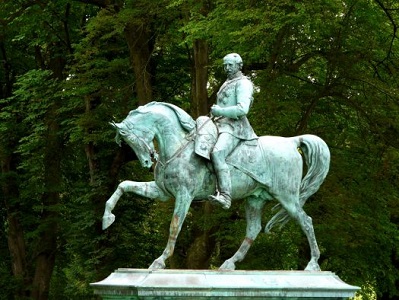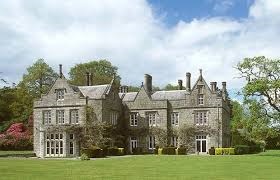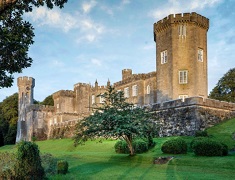Life
| 1779-1869 [Field-Marshall Hugh Viscount Gough]; son of Lt.-Col. George Gough and Letitia [née Bunbury], of “Lisnavagh”, Rathvilly, Co. Carlow [McClintock-Bunbury family seat, built 1696]; adj. of Col. Rochfort’s Foot (119th), 1794; capture of Cape with 78th Highlanders, 1795; m. Frances Maria Stephens, dg. of General Edward Stephens, June 1807; commander of 2nd Batt. at Talavera, 1809 and wounded; lieut.-col.; distinguished at Barossa and Tarifa, 1881; wounded at Nivelle, 1813; knighted and given freedom of Dublin, 1815; major-gen., 1830; KCB, 1831; captured Canton forts, 1841; appt. GCB; |
| created baronet for services in China, 1842; comm.-in-chief for India and defeated Mahrattas, 1843; conducted First Sikh War with successful battles of Mudki, 1845, Ferozeshah and Sobraon, both 1846; created Baron Gough; conducted second Sikh War, 1848, with closing battle at Goojerat, 21 Feb. 1849, leading to annexation of the Punjab; created Viscount; freedom of City of London with pension; general, 1854; KP, 1857; privy councillor, 1859; GCSI, 1861; |
| field-marshal, 1862; d. at his home, St. Helen’s Park [formerly Seaview], Merrion Rd., Co. Dublin [now a Radisson S.A.S. hotel, in 2020]; bur. with his wife at St. Brigid’s, Stillorgan; commemorated with an equestrian statue commissioned from John Foley by Dublin Corporation for the Phoenix Park, Dublin (unveiled 21 Feb. 1880) and beheaded by vandals in 1944, blown up by the IRA in 1957, and ultimately removed to Chillingham Castle, Northumberland, where it was restored and on display. ODNB |
 |
 |
| Equestrian statue by JH Foley — orig. in the Phoenix Park, Dublin, and removed to Chillingham after the bomb attack of 1958. | |
|
|
[ top ]
Commentary
Ronan Sheehan, Foley’s Asia (Dublin: Lilliput Press 1999) gives an account of Gough’s campaigns at Barossa with the 87th (attributing him with the cry, “Faugh a beallagh!” and “Eirigi .. rise up!”), Mahrajpore (where he loses 790 men and professes to his critics, “I will never be bate”; p.21.), Moodkee [sic], Ferozeshah (“I’ll wipe the Sakes [Sikhs] off de face of de earth”), Gujerat, &c. Quotes Sir John Mitchel, commanding the troops in Ireland: ‘Honoured I have been by the temporary deposit in my hands of this memorial of glory. I now surrender it to the safeguard of Ireland’s sons. Keep it, Irishmen, as an everlasting momento of your glory. Treasure it as a sacred deposit. Glory in it as the statue of one who was an honour to your country, one whose whole life, whetehr civil or military, was one continued career of kindness, konour, honesty of purpose, combined with the purest loyalty and the most enthusiastic patriotism. He was loved and honoured by his countrymen. He was par excellence our Irish chevalier, sans peur et sans reproche, and to wind up all, he was the heart and soul of an Irishman.’ (p.25.) Note: the tag sans peur .. &c., originally pertains to Pierre Terrail, seigneur de Bayard (d.1524).
[ top ]
References
|
Available at Wikipedia - online; access 25.02.2021. |
|
||||||
[ top ]
Notes
Kith & Kin?: John Gough (1721-1791) was master of the Friends’s School, Dublin, 1752-74 and afterwards at Lisburn; published a History of the People Called Quakers (1789-90), and a tract on non-payment of [Anglican] tithes. (See ODNB.)
Hugh Gough (Lieut.-Brigadier) was the highest-ranking officer involved in the Curragh Mutiny of May 1914 when 100 British Army officers refused to serve in Ulster in face of Unionist objections to the Home Rule Act of 1914 which gave rise to the Ulster Covenant and other marks of resistance on the part of the ‘planter’ community of Anglicans and Presbyterians in the region - led by Edward Carson and abetted by Randolph Churchill.
Note: A [Hugh] Gough was among those who contributed to the expense of acquiring Corot’s “Marseilles” for the Hugh Lane Collection (see Municipal Gallery, Dublin; Hugh Lane Gift, an exhib0tion of 2008.)
Hugh Rowlands Gough (1905-2011 ; Bishop of Sidney, Australia): Right Reverend Bishop Hugh Rowlands Gough, CMG, OBE, TD, was was born in Thandiani, Punjab, British Raj, into a clerical family, the son of Rev. Charles Massey Gough and his wife, Lizzie Middleton, missionaries on the North-West Frontier; ed. Trinity College, Cambridge; Curate of St Paul’s Walcot, Bath; Vicar of St James’ Carlisle; Chaplain in the British Armed Forces during World War II and Rural Dean of Islington, in 1946;a prebendary of St Paul’s Cathedral, London, 1948; elected Bishop of Barking, 1948-59 and concurrently served as Archdeacon of West Ham; translated Archbishop of Sydney serving as Primate of the Church of England in Australia; attacked atheist philosophers such as John Anderson at Sydney University for corrupting the youth, 1961; m. Hon. Madeline Elizabeth, 1929, dg. of Lord Kinnaird of Lytham Hall, with whom a dg. Lucy Gough (b.1931); resigned on following allegations of improper relationship with a married woman and left Australia, 1966.
Independent obituary (23 Oct.2011):
‘[The Right Reverend Hugh Gough] was elected to the Primacy of Australia by the Diocesan Bishops in October 1959 and he filled this role in a way that won well-deserved respect. The new Constitution for the Church in Australia came into effect on 1 January 1962 and it fell to Gough to preside over the first General Synod in May that year. As Primate he travelled widely in Australia, attended the World Council of Churches General Assembly at New Delhi in 1961, and took part in the Anglican Congress at Toronto in 1963. He carried out visits to CMS in Pakistan in 1964 and to the Australian Armed Forces in Malaya and Vietnam in 1965.
But the nervous strain of seven strenuous years took their toll in a serious breakdown in health early in 1966 and he resigned from the See, just seven years after his enthronement. For a short time, he was vicar of the little parish of Freshford in the diocese of Bath and Wells; then he retired altogether and made his home first in Bath and then in the Hampshire village of Over Wallop.’ (Available online; accessed 25.02.2021.)
[ top ]

